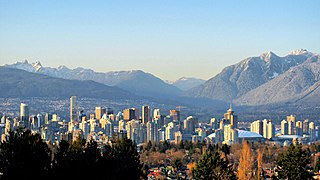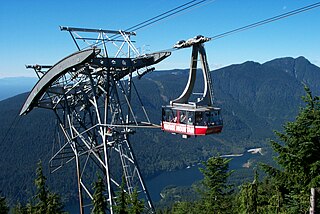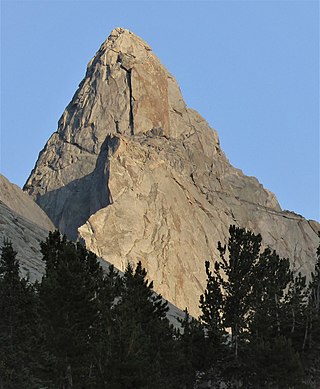
Mountain rescue refers to search and rescue activities that occur in a mountainous environment, although the term is sometimes also used to apply to search and rescue in other wilderness environments. This tends to include mountains with technical rope access issues, snow, avalanches, ice, crevasses, glaciers, alpine environments and high altitudes. The difficult and remote nature of the terrain in which mountain rescue often occurs has resulted in the development of a number of specific pieces of equipment and techniques. Helicopters are often used to quickly extract casualties, and search dogs may be deployed to find a casualty.

Mount Seymour is a mountain located in Mount Seymour Provincial Park in the District of North Vancouver, British Columbia, Canada. It is a part of the North Shore Mountains, rising to the north from the shores of Burrard Inlet and Indian Arm to a summit of 1,449 m (4,754 ft) above the Indian River and Deep Cove neighbourhoods. Mount Seymour is most commonly identified for its ski area of the same name, and as a popular hiking area. It is named in honour of Frederick Seymour, second governor of the Colony of British Columbia. The name is used to refer to the ridge although the main summit is one of several, and is also known as Third Peak.
The North Shore is a term commonly used to refer to several areas adjacent to Vancouver, British Columbia, Canada:

The Cirque of the Towers is located in the Wind River Range Wyoming, U.S., part of which is in the Bridger Wilderness in Bridger-Teton National Forest, while the remainder is in the Popo Agie Wilderness in Shoshone National Forest. Located in the southern section of the Wind River Range, the cirque is a very popular destination for technical rock climbers. Climber Orrin Bonney gave the area its current name in 1941 after his survey of the cirque. Prior to this, few if any visitors had ventured into the cirque due to the remote location. The cirque is an almost circular hole or valley carved by a glacier that retreated over 8,000 years ago. As is true with the rest of the Winds, the mountains are composed almost entirely of granite. The Continental Divide spans the crest of the main peaks.

Mount Bishop is a mountain located on the northern border of Mount Seymour Provincial Park in the District of North Vancouver, British Columbia. It is a part of the North Shore Mountains, rising from the shores of Indian Arm to a summit of 1,509 metres (4,951 ft). Mount Bishop is a rocky summit with bluffs and old growth on its lower slopes.

The North Shore Mountains are a mountain range overlooking Vancouver in British Columbia, Canada. Their southernmost peaks are visible from most areas in Vancouver and form a distinctive backdrop for the city.
Explorer Search and Rescue (ESAR) are teams of Explorers in the Learning for Life program of the Boy Scouts of America who are trained and deployed for search and rescue missions. Well-developed ESAR programs emerged in the state of Washington in the mid-1950s and were followed by others in California and elsewhere. The rugged, mountainous terrain of these areas often require massive amounts of manpower for proper searches for missing people, not to mention their rescue and evacuation from remote areas. The ESAR mission has also expanded over the years to include urban search and rescue and other disaster-related disciplines. Many ESAR groups also provide wilderness safety training to the public.

The Fannin Range is a small mountain range in the Pacific Ranges of the Coast Mountains of British Columbia, Canada. Lying between the Seymour River and the glacial fjord Indian Arm, the range extends from the slopes of Mount Seymour on the Burrard Inlet to the district of North Vancouver more than 34 kilometres north to the headwaters of the Indian River. It is named after the naturalist John Fannin It is commonly considered to be part of the North Shore Mountains.
A Mountain Locator Unit or MLU was a radio transmitter for use by mountain climbers as an emergency locator beacon when the wearer needs rescue.

Multnomah County Sheriff's Office Search and Rescue is a non-profit volunteer search and rescue resource for the Multnomah County Sheriff's Office in Multnomah County, Oregon, United States. The agency also offers its 3,000-5,000 hours of volunteer service to other areas, including Clackamas, Columbia, Washington, Marion, Hood River, Wasco, Tillamook, and Clatsop counties in Oregon, and Skamania and Clark counties in Washington. The organization was first created in 1961 in cooperation with the Boy Scouts of America, and is one of the longest continually used Explorer Search and Rescue units in the United States. In 1986, sponsorship of the MCSO SAR was transferred to the Multnomah County Sheriff's Office. MCSO SAR is part of the Mount Hood Search and Rescue Council. MCSO receives funding from the Department of Homeland Security within the Urban Area Security Initiative (UASI) to create a regional resource.

Mount Hood climbing accidents are incidents related to mountain climbing or hiking on Oregon's Mount Hood. As of 2007, about 10,000 people attempt to climb the mountain each year. As of May 2002, more than 130 people are known to have died climbing Mount Hood since records have been kept. One of the worst climbing accidents occurred in 1986, when seven teenagers and two school teachers froze to death while attempting to retreat from a storm.

The Helicopter Flight Rescue System (HFRS) is a helicopter insertion and extraction tool that utilizes a longline and Personnel Carrying Device System (PCDS) to carry human loads below a helicopter in flight. These systems are often referred to as "Long Line", "Short Haul", Class D Fixed Line (CDFL), and other terms, and is similar to other helicopter long line systems in use throughout the world. By extending a rescuer below the aircraft and allowing the aircraft to remain clear of obstacles while a rescue is performed, a pilot can insert/extract rescuers and subjects in most types of terrain.

Grouse Mountain is one of the North Shore Mountains of the Pacific Ranges in the District Municipality of North Vancouver, British Columbia, Canada. With a maximum elevation of over 1,200m (4,100ft) at its peak, the mountain is the site of an alpine ski area, Grouse Mountain Resort, which overlooks Metro Vancouver and has four chairlifts servicing 33 runs. In the summer, Grouse Mountain Resort features lumberjack shows, the "Birds in Motion" birds of prey demonstration, a scenic chairlift ride, disc golf, mountain biking, zip lining, tandem paragliding, helicopter tours, and guided ecowalks. Year-round operations include a 100-seat mountaintop theatre and a wildlife refuge. The mountain operates two aerial tramways, known officially as the Skyride. The Blue Skyride is used mainly for freight transportation, while public access to the mountain top is provided by the Swiss-built Garaventa Red Skyride, which has a maximum capacity of 101 passengers. Summer access is also provided by the 2.9 kilometre Grouse Grind hiking trail, which is open for hiking from May to October.
Portland Mountain Rescue is a search and rescue organization based in Portland, Oregon, United States. It specializes in high angle mountain rescue and mountain rescue in northwest Oregon and southwest Washington, as well as providing educational materials and information on mountain and backcountry safety. Secondary areas of operations include Central Oregon and western Washington. The organization is 100% volunteer and has about 65 field-deployable members.

Coquitlam Search and Rescue (SAR) is a volunteer, non-profit organization dedicated to wilderness search and rescue in the Coquitlam area of British Columbia, Canada. Its service area includes the communities of Anmore, Belcarra, Burnaby, Coquitlam, New Westminster, Port Coquitlam and Port Moody.
Timothy Edmund Jones was a Canadian Advanced Life Support Paramedic and Search and Rescue Technician. Jones was also a prominent media spokesperson and team leader for North Shore Rescue which is based in North Vancouver, British Columbia, Canada. He made significant contributions to the field of Search and Rescue and was an outspoken advocate for wilderness safety.

Mount Hooker is located in the Wind River Range in the U.S. state of Wyoming. Mount Hooker was named for Joseph Dalton Hooker, the prominent 19th-century British botanist and explorer. The north and east slopes of Mount Hooker present some of the tallest and steepest vertical cliffs in Wyoming, and the peak is also remote, being more than 20 mi (32 km) from a road. The formidable 1,800-foot (550 m) north face of Mount Hooker was first climbed in 1964 by Yosemite Valley climber Royal Robbins, along with Dick McCracken and Charlie Raymond, who took over three days to scale the cliff face. In 2013, a team free climbed one pitch rated at class 5.14a, grade VI during a multiple-day ascent requiring five other pitches rated above 5.12.

Mount Seymour Provincial Park is a park in Vancouver, British Columbia's North Shore Mountains. With an area of 35 square kilometres, it is located approximately 15 kilometres north of Downtown Vancouver. The park, named after Frederick Seymour, was established in 1936. Mount Seymour Provincial Park provides visitors with a variety of recreational activities and animals with natural habitat.

Haystack Mountain is an 11,978-foot-elevation (3,651-meter) mountain summit located in Sublette County of Wyoming, United States.

Steeple Peak is a 12,040-foot-elevation (3,670-meter) summit located in Sublette County of Wyoming, United States.
























